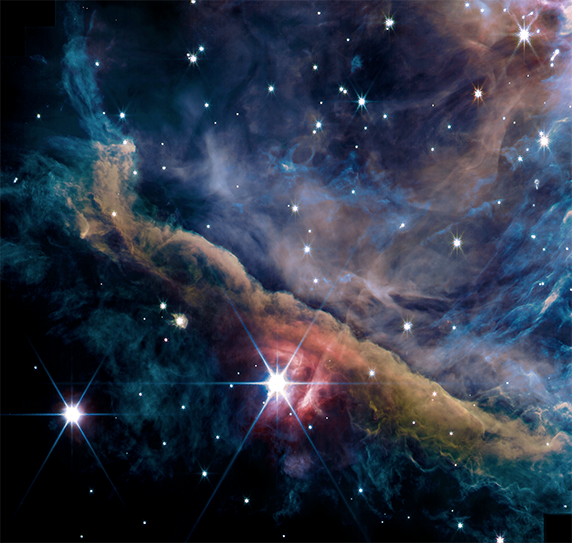|
Dive into the cradle of the stars... That’s what researchers have just captured with the James Webb Space Telescope : the most detailed and sharpest images ever taken of the inner region of the Orion Nebula. These observations were made possible and confirmed by Webb’s revolutionary capabilities.
Located in the constellation of Orion, 1350 light-years from Earth, the Orion Nebula is an area rich in material where many stars are formed. It would be an environment similar to the one where our system was born more than 4.5 billion years ago : studying it allows us to better understand the conditions prevailing at that time.
The heart of a stellar nursery, like the Orion Nebula, is obscured by large amounts of dust. It is impossible to observe it in visible light with telescopes like Hubble. The James Webb Space Telescope observes the infrared light of the cosmos, and thus allows us to see through these layers of dust. It finally lifts the veil on what is going on in the depths of the nebula.
It first reveals many spectacular structures, up to scales of about 40 AU1. Among them, a number of dense filaments of matter, which could favor the birth of a new generation of stars, as well as stellar systems in formation have been observed. The latter consist of a central protostar surrounded by a disk of dust and gas inside which planets are forming.
The Orion Nebula also harbors a cluster of massive young stars, called the Trapezium cluster, emitting intense ultraviolet radiation, capable of shaping the dust and gas clouds. Understanding how this phenomenon influences the environment is a key question for studying the formation of stellar systems like our own Solar System.
These results are the result of one of the James Webb priority observing programs, which involved about 100 scientists in 18 countries2 and was co-led by scientists from CNRS, Université Paris-Saclay and the University of Western Ontario (located in London, Canada). These programs were selected in an international call for proposals from the James Webb Space Telescope.
The research team is working to analyze the data collected about the Orion Nebula, and promises new discoveries about the early phases of the formation of stellar and planetary systems.
Notes
1- For Astronomical Unit. One AU corresponds approximately to the distance between the Earth and the Sun, 10 AU corresponds to the distance between Saturn and the Sun.
2- In France, this research involved scientists from the Institut de recherche en astrophysique et planétologie (CNRS/CNES/UT3 Paul Sabatier), from the Institut d’astrophysique spatiale (CNRS/Université Paris-Saclay) the Laboratoire d’études du rayonnement et de la matière en astrophysique et atmosphères (Observatoire de Paris - PSL/CNRS/Sorbonne Université/Université de Cergy-Pontoise), the Institut des sciences moléculaires d’Orsay (CNRS/Université Paris-Saclay), the Institut de planétologie et d’astrophysique de Grenoble (CNRS/UGA) the Laboratoire de physique de l’École normale supérieure (CNRS/ENS-PSL/Sorbonne University/Université Paris Cité), the Laboratoire de physique des deux infinis Irène Joliot-Curie (CNRS/Université Paris Saclay), the Institut de physique de Rennes(CNRS/Université de Rennes 1), the Institut d’astrophysique de Paris (CNRS/Sorbonne University), the Astrophysics, Instrumentation, Modeling Laboratory (CNRS/CEA/Université Paris Cité), the Institute of Molecular Sciences (CNRS/Institut polytechnique de Bordeaux/Université de Bordeaux), and the Laboratory of Quantum Chemistry and Physics (CNRS/UT3 Paul Sabatier)

Cette image a été obtenue avec l’instrument NIRCam du télescope spatial James Webb le 11 septembre 2022. Plusieurs images dans différents filtres ont été combinées pour créer cette image composite : F140M et F210M (bleu) ; F277W, F300M, F323N, F335M et F332W (vert) ; F405N (orange) ; et F444W, F480M et F470N (rouge).
This image was obtained with the NIRCam instrument on the James Webb Space Telescope on September 11, 2022. Several images in different filters were combined to create this composite image : F140M and F210M (blue) ; F277W, F300M, F323N, F335M, and F332W (green) ; F405N (orange) ; and F444W, F480M and F470N (red).

Filaments : l’image entière est riche en filaments de différentes tailles et formes. L’encart ici montre des filaments fins et sinueux qui sont particulièrement riches en molécules d’hydrocarbures et en hydrogène moléculaire. On pense qu’ils sont créés par les mouvements turbulents du gaz au sein de la nébuleuse.
θ2 Orionis A : l’étoile la plus brillante de cette image est θ2 Orionis A, une étoile qui est juste assez brillante pour être vue à l’œil nu depuis un endroit sombre sur Terre. La lumière stellaire qui se reflète sur les grains de poussière est à l’origine de la lueur rouge dans son environnement immédiat.
Jeune étoile à l’intérieur d’un globule : lorsque des nuages denses de gaz et de poussières deviennent instables, ils s’effondrent en embryons stellaires qui deviennent progressivement plus massifs jusqu’à ce qu’ils puissent entamer une fusion nucléaire dans leur noyau et commencer à briller. Cette jeune étoile est encore encastrée dans son nuage natal.

